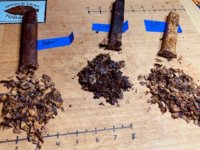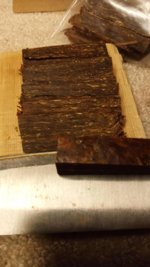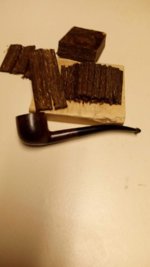You are using an out of date browser. It may not display this or other websites correctly.
You should upgrade or use an alternative browser.
You should upgrade or use an alternative browser.
Pure Tobacco Pipe Blends You Can Make
- Thread starter deluxestogie
- Start date
Indianapiper
Well-Known Member
I’m sorry for the stupid question Bob, I tried searching for it but didn’t have any luck. How do I read the parts per 16? Because 9+3 doesn’t equal 16?Help me I don’t understand it. Thanks sir
Marudnik is a superb blend for your first pipe of the day. In the Rhodope mountain range of southern Bulgaria, the source of the Krumovgrad tobacco variety, Marudnik (a pancake topped with yogurt or fruit) is more of a dessert than an appetizer.
Krumovgrad is a Basma-type Oriental tobacco. It's pouch aroma is quite floral, while the acidity of its smoke is not as pronounced as that of Basma, Yenidje or Xanthi. Like these latter three varieties, the burn of Krumovgrad is adequate, though not great. It's nicotine content is quite low. In this blend, I used Dark Air-Cured to balance the acidity and crank up the nicotine, while broadening the darker aspects of the aroma. When I substituted India Dark Air-Cured, the nicotine went up a notch, while maintaining the pH balance.

Марудник (Marudnik)
Download 3½" hi-res Marudnik blend label as pdf.
- Krumovgrad 81.25% (9 parts per 16)
- Dark Air-Cured 18.75% (3 parts per 16)
Bob
It's the New Math. The percentages are correct. The parts per 16 should be:
Марудник (Marudnik)
Bob
Марудник (Marudnik)
- Krumovgrad 81.25% (13 parts per 16)
- Dark Air-Cured 18.75% (3 parts per 16)
Bob
As a further comment on why I include "parts per 16".
Many years ago (15+), when I was discussing with the late Craig Tarler, who then was the owner and principal blender of C&D, having C&D make up my Pearl of Shibam blend for me, I discovered that all of his blending cards were recorded in parts per 16. Although sometimes fractions were involved, he said that it made it easy to blend up a pound. 16 ounces per pound. Likewise, multiples of pounds were equally easy for Craig to weigh-out and blend. C&D used weight.
My experience with the significant variability between batches or shipments of the same leaf (same variety, same curing, same priming level) even from commercial sources, suggested to me that weighing of the ingredients for a small batch is far more precise than the leaf itself. Finished tobacco leaf is an agricultural commodity, with all the variation which that entails.
So instead, I rely on the shred of each ingredient being similar, as well as the case of each ingredient being similar. That is, all of the ingredients have roughly the same density. Then I just measure my blends using volume--typically with a tablespoon.
So, for a small batch, "3 parts per 16" means 3 tablespoons of that ingredient will get tossed into my 1 gallon mixing Ziploc bag. My largest batches may triple the "parts per 16". I don't bring out a scale (or sensitive laboratory balance) or a slide rule. [Yup. I own 3 handsome slide rules, collecting dust as I type.]
"Parts per 16" doesn't have to be tablespoons. It could just as meaningfully mean actual ounces weight--if you like that sort of thing, or shoeboxes full or cups full or snow shovels full. My goal is to get within the margin of error of the ingredients themselves.
Bob
Many years ago (15+), when I was discussing with the late Craig Tarler, who then was the owner and principal blender of C&D, having C&D make up my Pearl of Shibam blend for me, I discovered that all of his blending cards were recorded in parts per 16. Although sometimes fractions were involved, he said that it made it easy to blend up a pound. 16 ounces per pound. Likewise, multiples of pounds were equally easy for Craig to weigh-out and blend. C&D used weight.
My experience with the significant variability between batches or shipments of the same leaf (same variety, same curing, same priming level) even from commercial sources, suggested to me that weighing of the ingredients for a small batch is far more precise than the leaf itself. Finished tobacco leaf is an agricultural commodity, with all the variation which that entails.
So instead, I rely on the shred of each ingredient being similar, as well as the case of each ingredient being similar. That is, all of the ingredients have roughly the same density. Then I just measure my blends using volume--typically with a tablespoon.
So, for a small batch, "3 parts per 16" means 3 tablespoons of that ingredient will get tossed into my 1 gallon mixing Ziploc bag. My largest batches may triple the "parts per 16". I don't bring out a scale (or sensitive laboratory balance) or a slide rule. [Yup. I own 3 handsome slide rules, collecting dust as I type.]
"Parts per 16" doesn't have to be tablespoons. It could just as meaningfully mean actual ounces weight--if you like that sort of thing, or shoeboxes full or cups full or snow shovels full. My goal is to get within the margin of error of the ingredients themselves.
Bob
GreenDragon
Well-Known Member
As a further comment on why I include "parts per 16".
Many years ago (15+), when I was discussing with the late Craig Tarler, who then was the owner and principal blender of C&D, having C&D make up my Pearl of Shibam blend for me, I discovered that all of his blending cards were recorded in parts per 16. Although sometimes fractions were involved, he said that it made it easy to blend up a pound. 16 ounces per pound. Likewise, multiples of pounds were equally easy for Craig to weigh-out and blend. C&D used weight.
My experience with the significant variability between batches or shipments of the same leaf (same variety, same curing, same priming level) even from commercial sources, suggested to me that weighing of the ingredients for a small batch is far more precise than the leaf itself. Finished tobacco leaf is an agricultural commodity, with all the variation which that entails.
So instead, I rely on the shred of each ingredient being similar, as well as the case of each ingredient being similar. That is, all of the ingredients have roughly the same density. Then I just measure my blends using volume--typically with a tablespoon.
So, for a small batch, "3 parts per 16" means 3 tablespoons of that ingredient will get tossed into my 1 gallon mixing Ziploc bag. My largest batches may triple the "parts per 16". I don't bring out a scale (or sensitive laboratory balance) or a slide rule. [Yup. I own 3 handsome slide rules, collecting dust as I type.]
"Parts per 16" doesn't have to be tablespoons. It could just as meaningfully mean actual ounces weight--if you like that sort of thing, or shoeboxes full or cups full or snow shovels full. My goal is to get within the margin of error of the ingredients themselves.
Bob
A simple, easy, and elegantly efficient system.
A simple Virginia plug I made using Virginia red, Bright, hand tied bright in equal parts and roughly 5-6% burley. I left it in the press for about 24 hours then sliced it with a sharp knife. Some flakes thin but most were thick. I'll leave them to dry down so that I can jar them. I probably have about 10 of these made now for the future. I'll have to get some Basma to make up some "Old guys blend" here soon !
Attachments
PressuredLeaf
Well-Known Member
Nice looking flake! I'm very curious to find out how it smokes, I bet the burley addition will be nice.A simple Virginia plug I made using Virginia red, Bright, hand tied bright in equal parts and roughly 5-6% burley. I left it in the press for about 24 hours then sliced it with a sharp knife. Some flakes thin but most were thick. I'll leave them to dry down so that I can jar them. I probably have about 10 of these made now for the future. I'll have to get some Basma to make up some "Old guys blend" here soon !
A simple Virginia plug I made using Virginia red, Bright, hand tied bright in equal parts and roughly 5-6% burley. I left it in the press for about 24 hours then sliced it with a sharp knife. Some flakes thin but most were thick. I'll leave them to dry down so that I can jar them. I probably have about 10 of these made now for the future. I'll have to get some Basma to make up some "Old guys blend" here soon !
I dont know why but plugs are always such a pleasure to look at. Nothing better than to see a tax free dense stick of homepressed tobacco
I smoked a small bowl of it when I was slicing it up, it was pretty good but will definitely be much better in a year or more. I was smoking a very similar flake that I made last April and it had a nice smooth, citrusy, dark fruit taste to it.Nice looking flake! I'm very curious to find out how it smokes, I bet the burley addition will be nice.
GreenDragon
Well-Known Member
Mixed up three blends a few days ago. Two from Bob’s excellent book: Basma Pastry Party and Flight Surgeon Deluxe. And a VaPer: two parts Va. Bright, 1 part Red Va., 1 part perique, and wrapped in 1/2 part dark air. I placed in my box press for two days and took two out to test. They were not cased enough for proper melding, so I liberally sprinkled some 12 year Scotch on them and popped them back in the press for a week. They smell heavenly. Will try the FSD tonight.


Heavenly, like tobacco, or heavenly like Scotch Whiskey?They smell heavenly.
Bob
GreenDragon
Well-Known Member
Surprisingly they don't smell of Scotch. More like a very rich tobacco / earthy chocolate aroma.
My experience with the significant variability between batches or shipments of the same leaf (same variety, same curing, same priming level) even from commercial sources, suggested to me that weighing of the ingredients for a small batch is far more precise than the leaf itself. Finished tobacco leaf is an agricultural commodity, with all the variation which that entails.
So instead, I rely on the shred of each ingredient being similar, as well as the case of each ingredient being similar. That is, all of the ingredients have roughly the same density. Then I just measure my blends using volume--typically with a tablespoon.
So, for a small batch, "3 parts per 16" means 3 tablespoons of that ingredient will get tossed into my 1 gallon mixing Ziploc bag. My largest batches may triple the "parts per 16". I don't bring out a scale (or sensitive laboratory balance) or a slide rule. [Yup. I own 3 handsome slide rules, collecting dust as I type.]
"Parts per 16" doesn't have to be tablespoons. It could just as meaningfully mean actual ounces weight--if you like that sort of thing, or shoeboxes full or cups full or snow shovels full. My goal is to get within the margin of error of the ingredients themselves.
Bob
I've often puzzled over the problem of mixing based on weight vs based on volume. If all the tobacco is the same density, structure, and same level of case, then weight seems like it would be most accurate. If I wanted a 50/50 blend of two similar VAs where the weight and volume of both types of leaf are the same, then weighing works as expected. But when I blend something like a bright VA that has very thin leaves with something dense like a dark fired wrapper the proportion of leaf by volume suddenly seems skewed towards the bright VA even if the weight is exactly 50/50. Does it ever make more sense to mix strictly by volume rather than weight? I'm never sure of the proper method when using very different types of leaf
I've often puzzled over the problem of mixing based on weight vs based on volume. If all the tobacco is the same density, structure, and same level of case, then weight seems like it would be most accurate. If I wanted a 50/50 blend of two similar VAs where the weight and volume of both types of leaf are the same, then weighing works as expected. But when I blend something like a bright VA that has very thin leaves with something dense like a dark fired wrapper the proportion of leaf by volume suddenly seems skewed towards the bright VA even if the weight is exactly 50/50. Does it ever make more sense to mix strictly by volume rather than weight? I'm never sure of the proper method when using very different types of leaf
I think batch size may also be a consideration. I blend for cigarettes at about a pound per batch and blend strictly by volume. With a tiny batch size you may have to experiment a little to determine whether volume or weight gives the more consistent batches. I don’t blend enough pipe blends to say with any experience.
Here’s my blend by volume method for cigarettes. It may or may not apply here.
Shredding/Blending by Volume
I shred for cigarettes by volume rather than by weight. I use a metric ruler to mark off the levels for each variety in the blend. I use 10cm for two reasons, 10cm of shredded tobacco in the plastic tub provided with the Powermatic Shredder yields right at 1 pound of shredded tobacco. Second...
Levi Gross
Well-Known Member
GreenDragon
Well-Known Member
I've weighed, measured, scooped.... they all seem to work equally well. It's all about what works for you and that you are consistent in your methods.
I start out weighing everything, which seems very satisfying and orderly. However, once I'm mixing if the proportion of one component looks off I just fudge and add more until it seems rights. I'm afraid I'm not very scientific about it.
Similar threads
- Replies
- 15
- Views
- 6K
- Replies
- 6
- Views
- 6K
-
About Us
This forum is dedicated to promoting the American tobacco farmer and tobacco home growers across the globe. Whether you grow by the acre, in your backyard, or in pots, you should find valuable and accurate information here.We discuss any variety of tobacco, as well as numerous approaches to growing, harvesting, curing, and finishing your crop. Our members will attempt to provide experience-based answers to your questions.
-
Buy raw tobacco from our Sponsor - WLT



